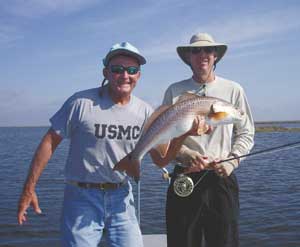
Many are here, and others are coming. Hunters who are knowledgeable about how and why ducks migrate can use that information to increase their success.
News of a disturbance in the Gulf can leave most folks around here tropically depressed, especially after last year’s Hurricane Season From Hell.But for the combat fly fisherman, it can be a call to arms. Knowing his adversaries in the marsh are energized by the flow of tidal surges, he maps his strategy for a post-storm fishing trip.
Back in the good ol’ days when I was low man on the corporate totem pole, I’d wait for such a storm to pass, then call my boss and tell him I was going to be sick tomorrow. Me and my buddies would then head down to our favorite coastal spot, and hit the falling storm tide.
On the rare occasion when my boss didn’t buy into this excuse, I always planned a trip for the upcoming weekend, knowing that the post-storm effect was good for several days.
Such was the case a few years ago. An early September tropical depression grazed the coast en route to Texas. I contacted my wife’s brother-in-law, Gerard, and his brother, Earl, and convinced them we needed to be at Catfish Lake that Saturday.
We pulled into the Golden Meadow boat launch at 5:30 a.m., my son Jacob and I in one boat, Earl and Gerard in another. The brothers headed into the lake, while we motored down to a pipeline canal southeast of the lake, then pulled into a dead-end that opened up to a shallow marsh pond.
Backs and tails were everywhere. The tails were sheepshead, the backs were reds.
On the third cast, a 7 1/2-pound red exploded on a green/white pencil popper. There were many more like him, and by midmorning, the score was 17 reds landed, five lost and at least a dozen blowups on poppers with no take.
Of the reds we landed, all blew up on poppers, but not all were hooked on poppers. That’s because Master Jake and I employed a little-known technique we refer to as “lure and switch.” It’s like “bait and switch,” except we flyrodders never use bait.
When a red missed Jake’s popper, I’d pick up a second rod loaded with a pink charlie, and throw it right back at the fish. On several occasions, the follow-up worked.
With this technique, we are always confident of catching fish on the fly.
At midday, we met up with Earl and Gerard. They had caught over 200 specks working a reef in Catfish Lake, but only had about 30 keepers.
We decided to join in. Much to our dismay, Earl and Gerard kept pulling in specks and some sand trout, while our Clousers came home all alone.
So once again, Master Jake and I employed our “lure and switch” technique, except this time there really was a lure involved. Using a sparkle beetle under a cork, I’d cast out and pop the cork a few times to draw them in. At first sign of a strike, I’d reel the rig in at lightspeed, while Jake cast his fly directly to where the strike occured, often with an immediate hookup.
Now, you’re probably wondering: How can this “lure and switch” work? What makes a speckled trout, obviously hungry for a plastic beetle, suddenly decide to eat a Clouser minnow instead, when the two don’t look alike?
To answer this, I’ll use an analogy. Let’s say I’m hungry for a snack. So I go to the pantry for a box of my favorites, Ritz crackers. But the box is empty. I could wait for my wife to return from the store, but there happens to be a box of wheat crackers staring me in the face. Though not my favorites, I spent all this energy getting off the sofa to get a snack, might as well eat the wheats.
Bringing a commie rod aboard has a side benefit as well. When someone asks how you caught all those fish, you don’t have to show them the fly rod. We don’t want everyone to know that flies catch more fish, now do we?


